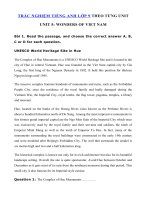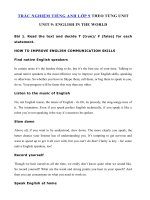Tải Trắc nghiệm Reading tiếng Anh lớp 12 Unit 3 The Green Movement - Bài tập Unit 3 lớp 12 The Green Movement có đáp án
Bạn đang xem bản rút gọn của tài liệu. Xem và tải ngay bản đầy đủ của tài liệu tại đây (91.69 KB, 9 trang )
<span class='text_page_counter'>(1)</span><div class='page_container' data-page=1>
<b>TRẮC NGHIỆM TIẾNG ANH 12 MỚI </b>
<b> THEO UNIT</b>
<b>UNIT 3: THE GREEN MOVEMENT</b>
<b>Bài 1. Read the following passage and mark the letter A, B, C or</b>
<b>D to indicate the correct answer to each of the questions.</b>
The poaching crisis wiping out Africa's elephants is costing the continent's economies
millions in lost tourism revenue, according to a new study. Researchers looked at visitor and
elephant data across 25 countries, and modeled financial losses from fewer visitors in
protected areas due to the illegal wildlife trade, which has caused elephant numbers to
plummet by more than 100,000 in the last decade. (A)
The study team combined visitor numbers across 164 protected areas in 25 countries in
forest and savannah elephants, and elephant population data from 2009 to 2013, to reach a
“per elephant" value in terms of tourism income.
They concluded that Africa was most likely losing $26m in tourism revenue a year. (B)
Around $9m of that is lost from tourists' direct spending, such as staying at hotels and
buying crafts, with the rest through indirect value in the economy such as farmers and other
suppliers supporting the tourist industry.
</div>
<span class='text_page_counter'>(2)</span><div class='page_container' data-page=2>
Naidoo said that the research was not suggesting economic issues should be the only
consideration when protecting elephants, but framing the poaching crisis as a financial one
could motivate African governments and communities.
“It gives an additional reason for some groups of people, who may not necessarily be
motivated by intrinsic reasons for conversation, to engage with biodiversity conservation. It
makes it clear to them that it's not just in the best interests of the world to conserve this stuff,
but tangible reasons for a whole different group," he said.
<b>Question 1:</b> The overall profit that the continent lost a year can be estimated to ____.
A. 25 million USD
B. 100,000 USD
C. 26 million USD
D. 9 million USD
<b>Question 2:</b> Which of the following statements is TRUE?
A. To get to the conclusion, scientists compared the changes in number of tourists and
number of elephants in 2009.
B. The only reason why illegal poaching is so difficult to stop is corruption.
C. Protecting elephants is for the both the practical and immaterial reasons.
D. There is an argument over the differences in the balance between the loss and the cost to
protect the elephants.
<b>Question 3:</b> Which of the following statements is NOT true?
</div>
<span class='text_page_counter'>(3)</span><div class='page_container' data-page=3>
B. The number of tourists reduces because now it is more difficult for them to see the
elephants in the wild.
C. One reason why elephants are killed in mass volume is from the increasing market of
ivory in South East Asia.
D. Relating poaching to financial benefits can be considered as one of the solutions to the
problem.
<b>Question 4:</b> Which of the positions marked in the passage does the phrase "but the
financial argument did not stack up in all areas,” best fit?
A. (A)
B. (B)
C. (C)
D. (D)
<b>Question 5:</b> The word plummet in paragraph 1 is closest in meaning to ____.
A. fall B. fluctuate
C. rise D. Stabilize
<b>Question 6:</b> The word sophisticated in paragraph 4 is closest in meaning to ____.
A. simple
</div>
<span class='text_page_counter'>(4)</span><div class='page_container' data-page=4>
<b>Question 7:</b> The word motivate in paragraph 5 is closest in meaning to ____.
A. change
B. design
C. form
D. inspire
<b>Question 8:</b> Which of the following is the best title for the passage?
A. Elephant poaching costs African millions in tourism revenue
B. Elephant poaching does more good than harm
C. Elephant poaching brings an opportunity for Africa to change
D. Elephant poaching reduces the number of elephants in Africa
<b>Bài 2. Read the following passage and mark the letter A, B, C, or</b>
<b>D on your answer sheet to indicate the correct answer to each</b>
<b>of the questions.</b>
Animation traditionally is done by hand-drawing or painting successive frame of an object,
each slightly different than the proceeding frame. In computer animation, although the
computer may be the one to draw the different frames, in most cases the artist will draw the
beginning and ending frames and the computer will produce the drawings between the first
and the last drawing. This is generally referred to as computer-assisted animation, because
the computer is more of a helper than an originator.
</div>
<span class='text_page_counter'>(5)</span><div class='page_container' data-page=5>
of endpoints, and color and intensity information. Highly trained professionals are needed to
produce such effects because animation that obtains high degrees of realism involves
computer techniques from three-dimensional transformation, shading, and curvatures.
High-tech computer animation for film involves very expensive computer systems along
with special color terminals or frame buffers. The frame buffer is nothing more than a giant
image memory for viewing a single frame. It temporarily holds the image for display on the
screen.
A camera can be used to film directly from the computer’s display screen, but for the highest
quality images possible, expensive film recorders are used. The computer computers the
positions and colors for the figures in the picture, and sends this information to the recorder,
which <b>captures</b> it on film. Sometimes, however, the images are stored on a large
magnetic disk before being sent to the recorder. <b>Once</b> this process is completed, it is
replaced for the next frame. When the entire sequence has been recorded on the film, the
film must be developed before the animation can be viewed. If the entire sequence does not
seem right, the motions must be corrected, recomputed, redisplayed, and rerecorded. This
approach can be very expensive and time – consuming. Often, computer-animation
companies first do motion tests with simple computer-generated line drawings before selling
their computers to the task of calculating the high-resolution, realistic-looking images.
<b>Question 9:</b> Which of the following statement is supported by the passage?
A. Computers have reduced the costs of animation.
B. In the future, traditional artists will no longer be needed.
C. Artists are unable to produce drawings as high in quality as computer drawings.
D. Animation involves a wide range of technical and artistic skills.
</div>
<span class='text_page_counter'>(6)</span><div class='page_container' data-page=6>
A. formulas B. objects
C. numbers D. database
<b>Question 11:</b> According to the passage, the frame buffers mentioned in the third
paragraph are used to ______
A. add color to the images
B. expose several frames at the same time
C. store individual images
D. create new frames
<b>Question 12:</b> According to the passage, the positions and colors of the figures in
high-tech animation are determined by _________
A. drawing several versions
B. enlarging one frame at a lime
C. analyzing the sequence from different angles
D. using computer calculations
<b>Question 13:</b> The word “captures” in the fourth paragraph is closest in meaning to
_____.
</div>
<span class='text_page_counter'>(7)</span><div class='page_container' data-page=7>
<b>Question 14:</b> The word “Once” in the fourth paragraph is closest in meaning to
______.
A. before
B. since
C. after
D. while
<b>Question 15:</b> According to the passage, how do computer-animation companies often
test motion?
A. They experiment with computer-generated line drawings.
B. They hand-draw successive frames.
C. They calculate high-resolutions images.
D. They develop extensive mathematical formulas.
<b>Bài 3. Chọn đáp án đúng nhất để hoàn thành bài khóa dưới đây.</b>
Computers have become (1) _________ of our daily lives. We visit shops, offices and places
of scenic (2) _________ with the help of computers. We pay bills prepared (3) _________
computers. We read newspapers and magazines (4) _________ contents have been produced
on computers. We receive letters from and send letters to (5) _________ every part of the
world with the help (6) _________ computers. In addition, we can (7) _________ learn
foreign languages on computers.
</div>
<span class='text_page_counter'>(8)</span><div class='page_container' data-page=8>
up calculations (13) _________ it can add, subtract, multiply, and (14) _________ with
lightning speed and perfect (15) _________.
A computers is also an electronic (16) _________ device which can manage large
collections of (17) _________. What is more, it is a (18) _________ typewriter which allows
us (19) _________ and print any kind of document. (20) _________ all, it is a personal
communicator which helps us to interact with each other very quickly and effectively.
1. A. part B. a part C. parts D. apart
2. A. beauties B. beautiful C. beauty D. beautified
3. A. with B. by C. for D. in
</div>
<span class='text_page_counter'>(9)</span><div class='page_container' data-page=9>
15. A. accurate B. accreted C. acutance D. accuracy
16. A. storage B. stored C. stores D. store
17. A. data B. datum C. data D. datum
18. A. magical B. magnified C. magic D. magnetic
19. A. to input B. inputting C. to input D. input
20. A. under B. among C. over D. above
<b>Đáp án</b>
1. C 2. C 3. A 4. C 5. A 6. C 7. D 8. A
9. D 10. B 11. C 12. D 13. A 14. C 15. A
<b>Bài 3. Chọn đáp án đúng nhất để hoàn thành bài khóa dưới đây.</b>
1 - B; 2 - C; 3 - B; 4 - C; 5 - A; 6 - D; 7 - A; 8 - C; 9 - B; 10 - A;
11 - D; 12 - C; 13 - B; 14 - A; 15 - D; 16 - A; 17 - A; 18 - A; 19 - C; 20 - C;\
Mời bạn đọc tham khảo thêm tài liệu Tiếng Anh lớp 12 tại đây:
Bài tập Tiếng Anh lớp 12 theo từng Unit:
</div>
<!--links-->









